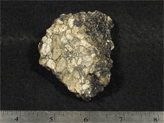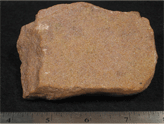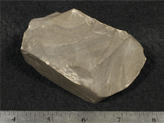
Clastic Sedimentary Rocks
Clastic sedimentary rocks are made up of pieces of other rocks. For example, sand on a beach or in a dune can get buried. Under the pressure of burial, the sand is pressed together and compacted. The individual sand grains are glued together by minerals such as calcite (calcium carbonate) and hematite (iron oxide) that are precipitated (see chemical sedimentary rocks) out of ground water that travels between the sand grains.
The name of a sedimentary rock depends on the size (and sometimes the shape) of the rock pieces that it is made of:
 Conglomerate is composed of rounded gravel, pebbles, cobbles, or boulders along with smaller rock pieces.
Conglomerate is composed of rounded gravel, pebbles, cobbles, or boulders along with smaller rock pieces. Breccia is similar to a conglomerate except its gravel, pebbles, cobbles, or boulders have a sharper, angular shape.
Breccia is similar to a conglomerate except its gravel, pebbles, cobbles, or boulders have a sharper, angular shape. Sandstone is composed of sand.
Sandstone is composed of sand. Siltstone is composed of silt.
Siltstone is composed of silt. Shale is composed of clay sized particles. The word "clay" can mean several different things to a geologist. In this case, clay means very small (smaller than 0.000004 meters in diameter) rock particles.
Shale is composed of clay sized particles. The word "clay" can mean several different things to a geologist. In this case, clay means very small (smaller than 0.000004 meters in diameter) rock particles.
The difference in particle size tells a lot about what kind of place that the rock formed in. We will find mud, not large cobbles, in the middle of a quiet lake. The rock that can eventually form that mud is a shale. We do find gravel, pebbles, cobbles, and boulders in the middle of a mountain stream. A conglomerate can form from these materials.
| Previous Item: Sedimentary Rocks |
Go Up: Learn About Rocks |
Next Item: Chemical Sedimentary Rocks |

